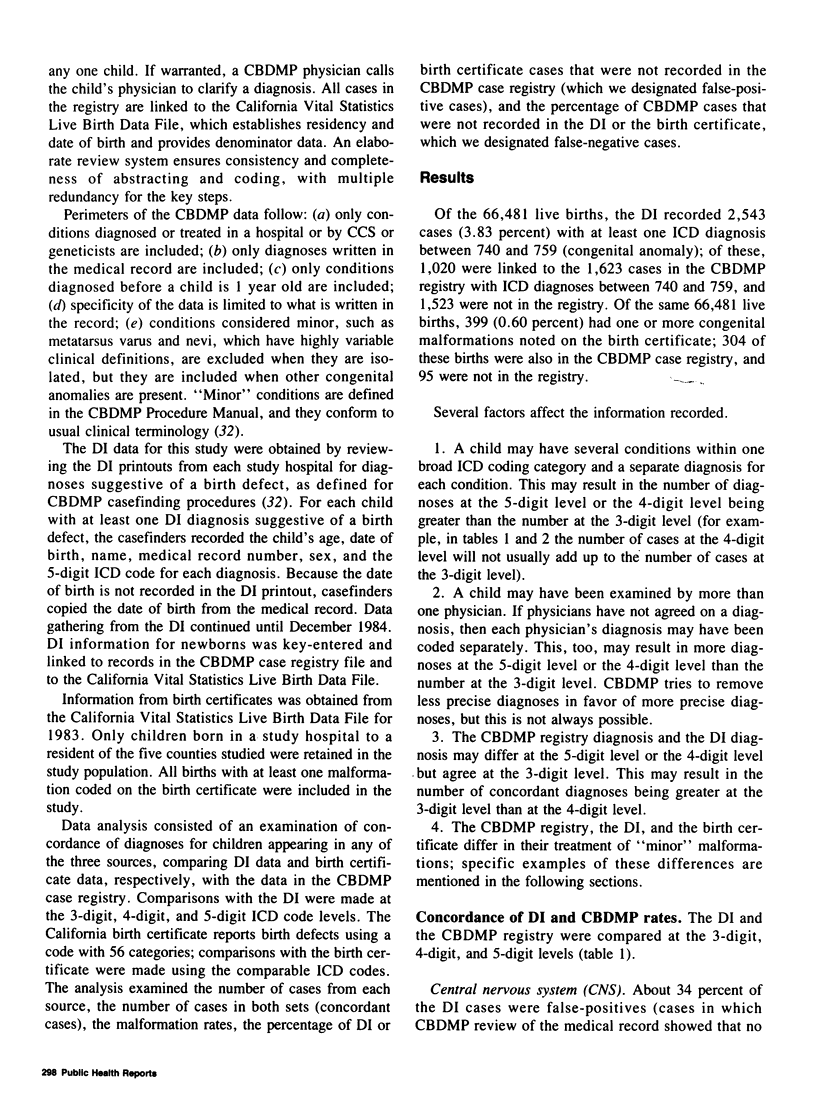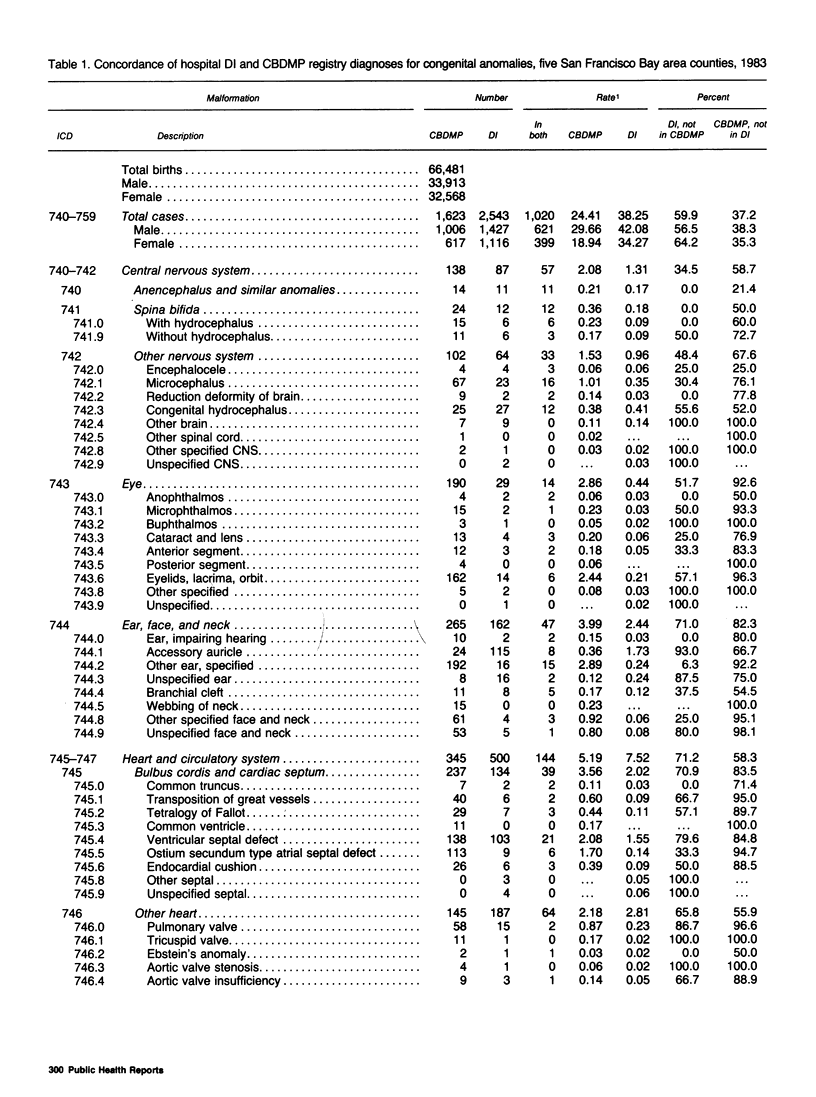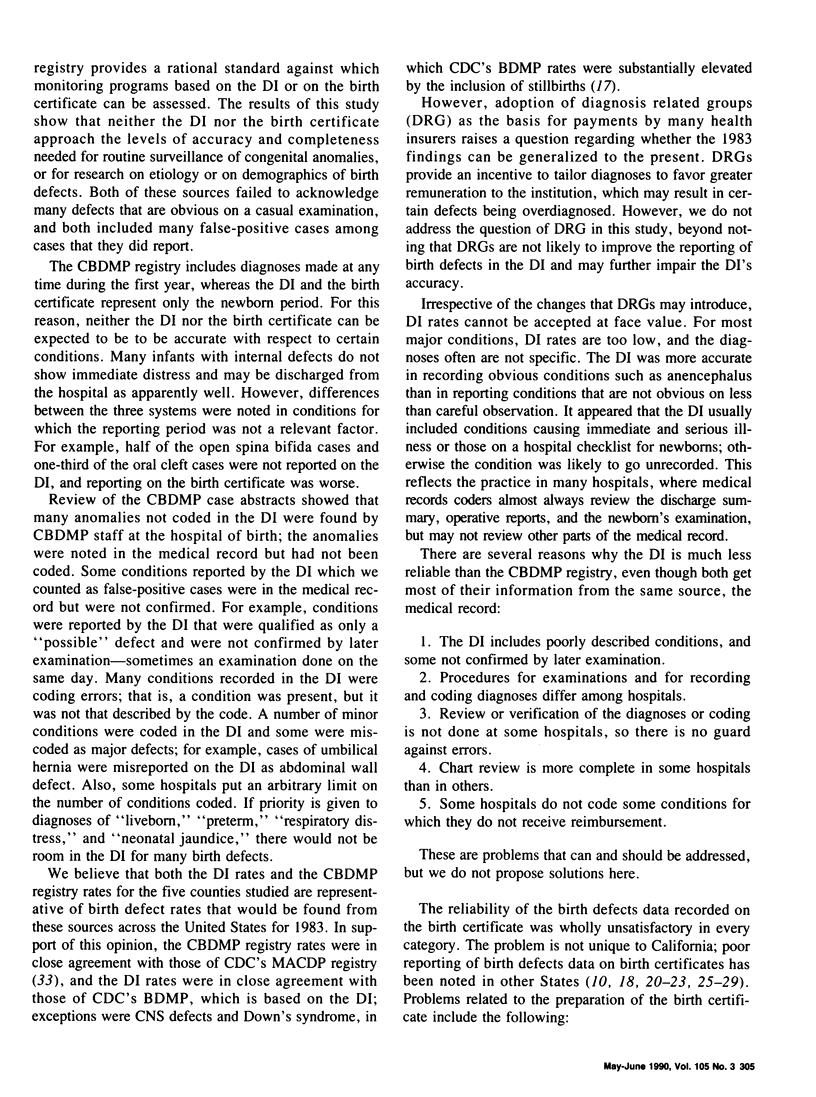Abstract
The hospital discharge diagnoses index (DI) for newborns and the birth certificate were evaluated as sources of information about birth defects by comparing them with the same births in the case registry of the California Birth Defects Monitoring Program (CBDMP). The CBDMP is an active surveillance system; the staff visit hospitals to identify children with birth defects diagnosed in the first year of life. The study population comprised 66,481 live births to residents of five counties in the San Francisco Bay area in 1983. Of these infants, 2,543 had at least one birth defect noted on the DI, and 1,623 were in the CBDMP registry; 1,020 with defects noted on the DI were also in the CBDMP registry. For this same population, 399 infants had one or more defects noted on the birth certificate; 304 of these were also in the CBDMP registry. Reporting of birth defects on the birth certificate was poor for every condition. Reporting on the DI was most reliable for oral clefts and chromosomal defects; for these defects, the DI omitted one-third of the cases but had identified only about 10 percent false-positive (that is, unverified) cases. Major central nervous system malformations were less well reported, with about one-third of them false-positive. For all other birth defects, the DI either omitted more than half of the cases, or more than half of the cases reported were false-positive cases. These findings raise questions about the validity of analytic studies of birth defects if the data are obtained only from the DI or the birth certificate.
Full text
PDF











Selected References
These references are in PubMed. This may not be the complete list of references from this article.
- Cole S. K. Evaluation of a neonatal discharge record as a monitor of congenital malformations. Community Med. 1983 Feb;5(1):21–30. doi: 10.1007/BF02548580. [DOI] [PubMed] [Google Scholar]
- Edmonds L. D., Layde P. M., James L. M., Flynt J. W., Erickson J. D., Oakley G. P., Jr Congenital malformations surveillance: two American systems. Int J Epidemiol. 1981 Sep;10(3):247–252. doi: 10.1093/ije/10.3.247. [DOI] [PubMed] [Google Scholar]
- Ericson A., Källén B., Winberg J. Surveillance of malformations at birth: a comparison of two record systems run in parallel. Int J Epidemiol. 1977 Mar;6(1):35–41. doi: 10.1093/ije/6.1.35. [DOI] [PubMed] [Google Scholar]
- Foster F. H. The New Zealand congenital anomaly register. N Z Med J. 1984 Mar 14;97(751):150–153. [PubMed] [Google Scholar]
- Fraser R., Beral V., Chilvers C. Monitoring disease in England and Wales: methods applicable to routine data-collecting systems. J Epidemiol Community Health. 1978 Dec;32(4):294–302. doi: 10.1136/jech.32.4.294. [DOI] [PMC free article] [PubMed] [Google Scholar]
- Frost F., Starzyk P., George S., McLaughlin J. F. Birth complication reporting: the effect of birth certificate design. Am J Public Health. 1984 May;74(5):505–506. doi: 10.2105/ajph.74.5.505. [DOI] [PMC free article] [PubMed] [Google Scholar]
- Green H. G., Nelson C. J., Gaylor D. W., Holson J. F. Accuracy of birth certificate data for detecting facial cleft defects in Arkansas children. Cleft Palate J. 1979 Apr;16(2):167–170. [PubMed] [Google Scholar]
- Holtzman N. A., Khoury M. J. Monitoring for congenital malformations. Annu Rev Public Health. 1986;7:237–266. doi: 10.1146/annurev.pu.07.050186.001321. [DOI] [PubMed] [Google Scholar]
- Johnson K. M., Huether C. A., Hook E. B., Crowe C. A., Reeder B. A., Sommer A., McCorquodale M. M., Cross P. K. False-positive reporting of Down syndrome on Ohio and New York birth certificates. Genet Epidemiol. 1985;2(2):123–131. doi: 10.1002/gepi.1370020203. [DOI] [PubMed] [Google Scholar]
- Klingberg M. A., Papier C. M., Hart J. Birth defects monitoring. Am J Ind Med. 1983;4(1-2):309–328. [PubMed] [Google Scholar]
- Knox E. G., Armstrong E. H., Lancashire R. The quality of notification of congenital malformations. J Epidemiol Community Health. 1984 Dec;38(4):296–305. doi: 10.1136/jech.38.4.296. [DOI] [PMC free article] [PubMed] [Google Scholar]
- Mackeprang M., Hay S., Lunde A. S. Completeness and accuracy of reporting of malformations on birth certificates. HSMHA Health Rep. 1972 Jan;87(1):43–49. [PMC free article] [PubMed] [Google Scholar]
- Mackeprang M., Hay S. Reporting of congenital malformations on birth certificates. Health Serv Rep. 1972 Nov;87(9):830–834. [PMC free article] [PubMed] [Google Scholar]
- Schwartz D. A., LoGerfo J. P. Congenital limb reduction defects in the agricultural setting. Am J Public Health. 1988 Jun;78(6):654–658. doi: 10.2105/ajph.78.6.654. [DOI] [PMC free article] [PubMed] [Google Scholar]
- Stone D. H., Hamilton F. M. Uses and limitations of registers of congenital malformations: a case-study. Public Health. 1987 May;101(3):191–197. doi: 10.1016/s0033-3506(87)80067-7. [DOI] [PubMed] [Google Scholar]
- Venters M., Schacht L., Bensel R. T. Reporting of Down's syndrome from birth certificate data in the State of Minnesota. Am J Public Health. 1976 Nov;66(11):1099–1100. doi: 10.2105/ajph.66.11.1099. [DOI] [PMC free article] [PubMed] [Google Scholar]
- Weatherall J. A., Haskey J. C. Surveillance of malformations. Br Med Bull. 1976 Jan;32(1):39–44. doi: 10.1093/oxfordjournals.bmb.a071321. [DOI] [PubMed] [Google Scholar]


